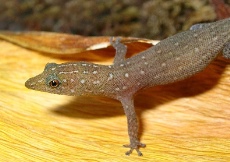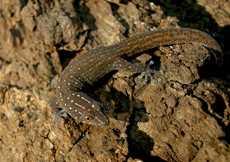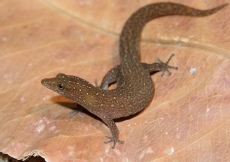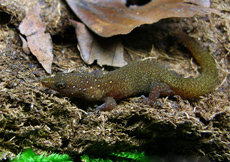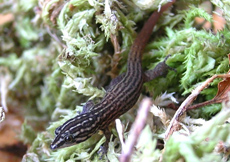Sphaerodactylus argus
(GOSSE, 1850)
Distribution:
Sphaerodactylus argus can be found in Central America and the Antilles in the following countries: Mexico, Nicaragua, Costa Rica, Panama, Jamaica, Cuba, Bahamas, Florida (introduced, but most probably now extinct). The subspecies Sphaerodactylus argus andresensis can only be found in San Andres (Colombia).
Description:
Sphaerodactylus argus is one of the medium sized species of the genus Sphaerodactylus with an overall length slightly over 6 centimeters. Their body is stocky and quite compact. The tail and body are almost equal in length. The females of this species are light brown in color. Their head has yellow dots that are sometimes connected to lines, these extend from the snout to the neck area. Because of these points this species was named after the giant Argus/Argos in Greek mythology described to have 100 eyes. The tail is yellow brown with dark marbling. Males look very similar, only the head pattern is blurred. Young animals of Sphaerodactylus argus have more contrast, bright lines from the head to the tail can be seen over their dark base color. Their tails are reddish brown.
Habitat:
Sphaerodactylus argus is found in dry to semi-arid habitats from sea level to 100 meters above sea level. They are ground dwellers and can be found hiding in the leaf litter under rotten wood and other locations close to ground.
Husbandry and Breeding:
A pair can easily be housed in a 20cm cube. Suitable substrate consists of coconut humus or soil and sand mixture, with isopods living amongst the substrate. Hiding places may be provided by laying pieces of cork and climbing plants, such as Pilea sp. around the enclosure. In order to provide the animals with climbing opportunities, pieces of bark and stem segments of Japanese knotweed (Fallopia japonica) should be angled around the terrarium walls. Holes may be cut in the knotweed to serve as nesting sites for the females. A small shallow water bowl and a bowl of crushed up cuttlefish bone are a must in completing the setup.
The required daytime temperature of 26-28°C (79-82°F) can be achieved by compact fluorescent tubes. During the Spring and Summer months the terrarium should be illuminated 12 hours daily. In the Winter months this should be reduced to 10 hours. In the winter months temperatures at night may safely drop to 18°C (64°F), daytime temperatures may be as low as 24°C (75°F). Since Sphaerodactylus argus inhabits drier habitats in nature it is enough to mist the terrarium every 2 days, provided a shallow drinking bowl is provided, thus achieving the relative humidity between 50-60%.
Feeding may be done 2-3 times weekly. Any insects fed should be the appropriate size and dusted with the proper vitamins at every feeding. A varied diet promotes the well being of the animals!
The breeding of this type is problem free. When the female is fed abundantly, a single egg may be laid every 18-20 days. Whether or not the adult geckos chase after the hatchlings is unknown, therefore the eggs should be transferred to an incubator. At a constant incubation temperature of 28°C (82°F) the young hatch after 100 days measuring 2.8-3 centimeters. The young can be safely raised in 1.3 liter household containers, the containers should be setup similar to the adults enclosure. The young may be raised in small groups with other representatives of the genus Sphaerodactylus. The young animals are fed with springtails, micro crickets, wax moth larvae and small meadow plankton for example.
Sphaerodactylus argus while not the most attractive color representative of the genus Sphaerodactylus is still worth while due to their ease of breeding, entertainment value and coloring and contrast of the young. Therefore even beginners may take on these dwarf geckos.
